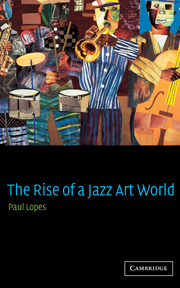Book contents
- Frontmatter
- Contents
- Acknowledgments
- Introduction: The quest for cultural legitimacy
- 1 Before the Jazz Age: professional musicians and good music
- 2 The Jazz Age: professional musicians and the cultivated vernacular
- 3 The swing craze: professional musicians, swing music, and the art of improvisation
- 4 The rise of a jazz art world: jazz enthusiasts, professional musicians, and the modernist revolt
- 5 The New Jazz Age: the jazz art world and the modern jazz renaissance
- Conclusion: The jazz art world and American culture
- Bibliography
- Index
2 - The Jazz Age: professional musicians and the cultivated vernacular
Published online by Cambridge University Press: 22 September 2009
- Frontmatter
- Contents
- Acknowledgments
- Introduction: The quest for cultural legitimacy
- 1 Before the Jazz Age: professional musicians and good music
- 2 The Jazz Age: professional musicians and the cultivated vernacular
- 3 The swing craze: professional musicians, swing music, and the art of improvisation
- 4 The rise of a jazz art world: jazz enthusiasts, professional musicians, and the modernist revolt
- 5 The New Jazz Age: the jazz art world and the modern jazz renaissance
- Conclusion: The jazz art world and American culture
- Bibliography
- Index
Summary
The fact that jazz is our current mode of expression, has reference to our time and the way we think and talk, is interesting; but if jazz music weren't itself good the subject would be more suitable for a sociologist than for an admirer of the gay arts. Fortunately the music and the way it is played are both of great interest, both have qualities that cannot be despised; and the cry that jazz is the enthusiastic disorganization of music is as extravagant as the prophecy that if we do not stop “jazzing” we will go down, as a nation, into ruin … Jazz for us, isn't the last feverish excitement, a spasm of energy before death. It is the normal development of our resources, the expected, and wonderful, arrival of America at a point of creative intensity.
Gilbert Seldes, “Toujours Jazz,” Dial August 1923: 151As an advocate of popular culture, the famous journalist Gilbert Seldes was an early defender of jazz music. In defending jazz, he pointed in particular to the symphonic jazz made famous during the 1920s by the highly successful jazz orchestras of Paul Whiteman and Vincent Lopez. Seldes was not alone in defending jazz against its numerous critics, or in posing professional jazz orchestras as testament to the legitimate, national, and artistic character of jazz music.
- Type
- Chapter
- Information
- The Rise of a Jazz Art World , pp. 46 - 95Publisher: Cambridge University PressPrint publication year: 2002



